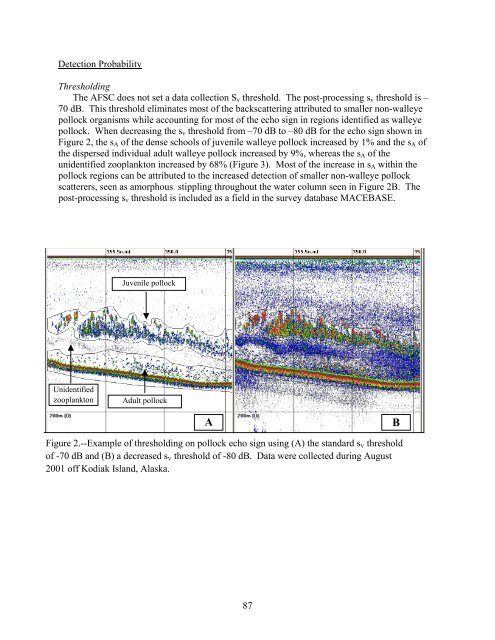NOAA Protocols for Fisheries Acoustics Surveys and Related ...
NOAA Protocols for Fisheries Acoustics Surveys and Related ...
NOAA Protocols for Fisheries Acoustics Surveys and Related ...
You also want an ePaper? Increase the reach of your titles
YUMPU automatically turns print PDFs into web optimized ePapers that Google loves.
Detection Probability<br />
Thresholding<br />
The AFSC does not set a data collection S v threshold. The post-processing s v threshold is –<br />
70 dB. This threshold eliminates most of the backscattering attributed to smaller non-walleye<br />
pollock organisms while accounting <strong>for</strong> most of the echo sign in regions identified as walleye<br />
pollock. When decreasing the s v threshold from –70 dB to –80 dB <strong>for</strong> the echo sign shown in<br />
Figure 2, the s A of the dense schools of juvenile walleye pollock increased by 1% <strong>and</strong> the s A of<br />
the dispersed individual adult walleye pollock increased by 9%, whereas the s A of the<br />
unidentified zooplankton increased by 68% (Figure 3). Most of the increase in s A within the<br />
pollock regions can be attributed to the increased detection of smaller non-walleye pollock<br />
scatterers, seen as amorphous stippling throughout the water column seen in Figure 2B. The<br />
post-processing s v threshold is included as a field in the survey database MACEBASE.<br />
Juvenile pollock<br />
Unidentified<br />
zooplankton<br />
Adult pollock<br />
A<br />
B<br />
Figure 2.--Example of thresholding on pollock echo sign using (A) the st<strong>and</strong>ard s V threshold<br />
of -70 dB <strong>and</strong> (B) a decreased s V threshold of -80 dB. Data were collected during August<br />
2001 off Kodiak Isl<strong>and</strong>, Alaska.<br />
87
















